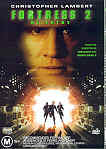

 |
|
|
|
|
|
||
| Category | Action | Theatrical Trailer(s) | Yes, 1 - 1.78:1, Dolby Digital 2.0 (1:30) |
| Rating | Other Trailer(s) | Yes, 1 - Dolby Digital City | |
| Year Released | 1999 | Commentary Tracks | None |
| Running Time | 89:01 Minutes | Other Extras | Featurette - Behind The Scenes (3:51)
Cast Biographies |
| RSDL/Flipper | No/No |
|
|
| Start Up | Menu | ||
| Region | 2,4 | Director | Geoff Murphy |
| Studio
Distributor |

Columbia TriStar |
Starring | Christopher Lambert
Pam Grier Liz May Brice Anthony C. Hall Willie Garson Yuji Okumoto |
| Case | Transparent Amaray | ||
| RRP | $39.95 | Music | Christopher Franke |
|
|
|
||
| Pan & Scan/Full Frame | None | MPEG | None |
| Widescreen Aspect Ratio | 1.78:1 | Dolby Digital | 5.1 |
| 16x9 Enhancement |
 |
Soundtrack Languages | English (Dolby Digital 5.1, 448 Kb/s)
German (Dolby Digital 5.1, 448 Kb/s) |
| Theatrical Aspect Ratio | 1.85:1 |
|
|
| Macrovision | Yes | Smoking | No |
| Subtitles | English
German Dutch Arabic Czech Danish Finnish Greek Hebrew Hindu Hungarian Icelandic Norwegian Polish Swedish Turkish |
Annoying Product Placement | No |
| Action In or After Credits | No | ||
To tell you any more about this film would spoil the surprise, so I am just going to say that plot-wise, this film only ranks slightly above Simon Sez, which I would have to rate as one of the worst examples of people being allowed to act when they shouldn't. Admittedly, this sequel is as entertaining as its predecessor, but that is not saying a lot, and it certainly isn't saying enough to justify the forty dollars that Columbia Tristar expects you to shell out for this disc. The implied threat to Karen Brennick (Beth Toussiant) and her son Danny (Adrian Rea), who is now about ten years old as opposed to a developing embryo as was the case in the original film, is nowhere near as pernicious this time around. Sadly, this threat was one thing that made the original Fortress as entertaining as it was. This is definitely a rental-only film.
The colours are purposefully muted and dull, reflecting the sterile and oppressive environment of the prison. It is interesting to note that the transfer does not take on any life during the few outdoor scenes, either, which would help the implication that the outside world is just as much a prison under the Men-Tel corporation as it is within their "power stations".
MPEG artefacts were happily absent from the transfer, as were film-to-video artefacts, which gave this transfer a very clean and film-like feel to it. Sadly, film artefacts were found in an excessive amount, although they weren't particularly intrusive. Suffice it to say that the film has a look about it that suggests it was stored in the archives of an independent studio for six months, with the occasional small-to-medium white fleck and the odd black mark here and there making themselves known at one point or another. Most people will not notice these marks in the picture, but those of you out there who look into the picture with discerning eyes will wonder how so many marks can get onto a six-month-old negative.
The score music is credited to one Christopher Franke, but I couldn't help feeling it was pretty similar to the scores for most other action films that I can never quite remember. In any case, it helped create a pleasant, paced feeling within what is mostly a very slow film. There's just nothing remarkable, good or bad, about this score, except maybe for the fact that it was quite recessed in the overall mix until the end credits began to roll. Either that or it suddenly became a lot more dynamic during the end credits.
The surround presence of this disc is rather under-utilized as far as I could discern, with only the occasional mild dose of music and special effects coming out of the rears, giving a very frontal feel to the mix. There seemed to be very little in the mix that really required a surround presence, but nevertheless, the surrounds spent an awful amount of time twiddling their thumbs. Sometimes there would be a heavier sound coming from the rears, such as the spin of a helicopter rotor, but it seemed to be mixed so low that it might as well have not been there.
The subwoofer was well-integrated into the mix, supporting the explosions, gunshots, and punches with a generally powerful bottom-end.
The video quality is excellent, except for a surprisingly high number of film artefacts.
The audio quality is rather limited, but good enough considering the film itself.
It's a good thing that Columbia Tristar have dropped
the pretence and stopped using their extras to justify the higher price
tag, because this selection doesn't cut the mustard.
| Video | |
| Audio | |
| Extras | |
| Plot | |
| Overall |
|
|
|
| DVD | Grundig GDV 100 D, using composite output; Toshiba SD-2109, using S-video output |
| Display | Panasonic TC-29R20 (68 cm), 4:3 mode, using composite input; Samsung CS-823AMF (80 cm), 16:9 mode/4:3 mode, using composite and S-video inputs |
| Audio Decoder | Built In (Amplifier) |
| Amplification | Sony STR-DE835 |
| Speakers | Panasonic S-J1500D Front Speakers, Philips PH931SSS Rear Speakers, Philips FB206WC Centre Speaker, JBL Digital 10 Subwoofer |